How to charge the smartphone
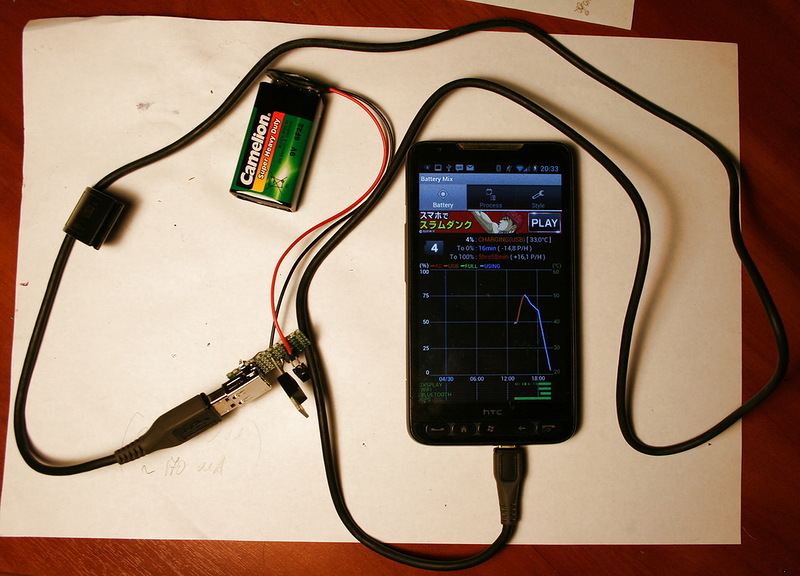
We are trying to charge the phone from the crown through the KREN5A chip
Not so long ago, on the Habré, a post “ When the battery sits down ” jumped , striking in its illiteracy. Everything would be fine, but this post even managed to appear on the main page, as a result, many people read it, and the author mislead them in a criminal manner. To show the incorrectness of the post, the experiment was repeated with the utmost meticulousness: the registration of currents and voltages. It also explains why this is impossible, and what to do if you really want to charge the phone with batteries.
Welcome under cat.
What is the problem?
')
Let's immediately mark the moments that ne_kotin indicated in the post, and they are incorrect.
The author says
I want something powerful (1.5 - 2 amps) and inexpensive - preferably up to 100 rubles. To be able to solder on the knee.
And I still have them!
This phrase is the main thing - that is misleading, and indicates the complete incompetence of the author. The chip itself KREN5A - can work with currents of 1.5-2 A, but the question is whether the battery can give the battery to the crown, the author left behind the scenes.
Further, the author provides a scheme that can be easily simplified by removing unnecessary capacitors (the battery itself is capacity). And after that, the author confidently claims that he manages to charge phones with this device. He confidently speaks about absurd things, and attempts to convince him and remove the post were not crowned with success.
In the comments a real holivar was delivered, serious electronic engineers laughed at this article. Even in the well-known LJ community dedicated to radio electronics, a flurry of indignation erupted at this post.
So, our goal: to check the theorem of the existence of the possibility of charging from the crown, through a KREN5A (or KREN5B) chip of a smartphone, and what current this battery will give when charging.
Sources and Build
To check the existence, we need not so much: mounting, USB-connector, the microcircuit itself, charging wire, smartphone, connector for connecting the crown, multimeter with current measurement capability + optionally straight arms and soldering iron :).
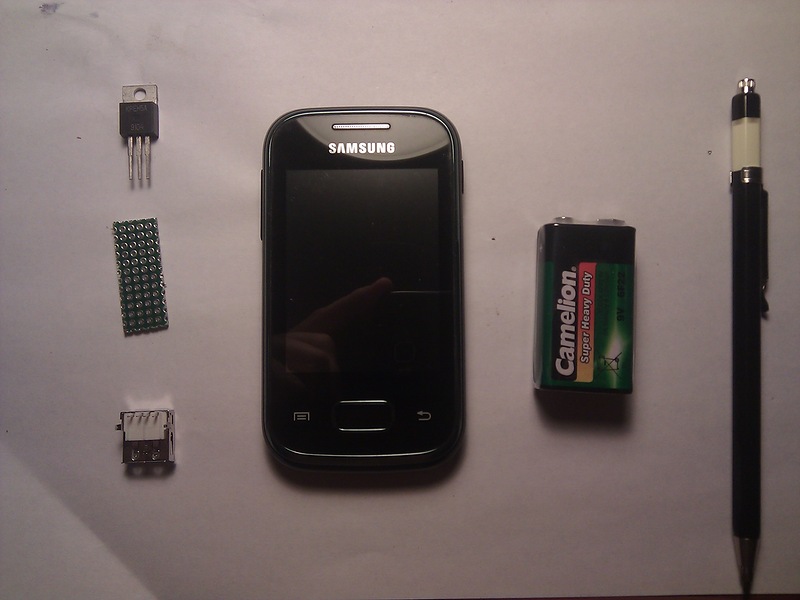
Some sources
Not the one on the photo, but the HTC HD2 with a bucket onboard, was chosen as a rechargeable smartphone. It so happened that in the course of the experiments it turned out that the smartphone above after an unsuccessful flashing is terribly buggy and does not allow to install third-party software. Charge-discharge control was carried out by the Battery Mix program.
For experiments, a new crown was acquired in the first newspaper stall at the exit of the metro.

Sealed battery
We collect according to the scheme, as indicated in the criticized post, we do not install only capacitors.

Device Assembly
We check that we have the required voltage at the output
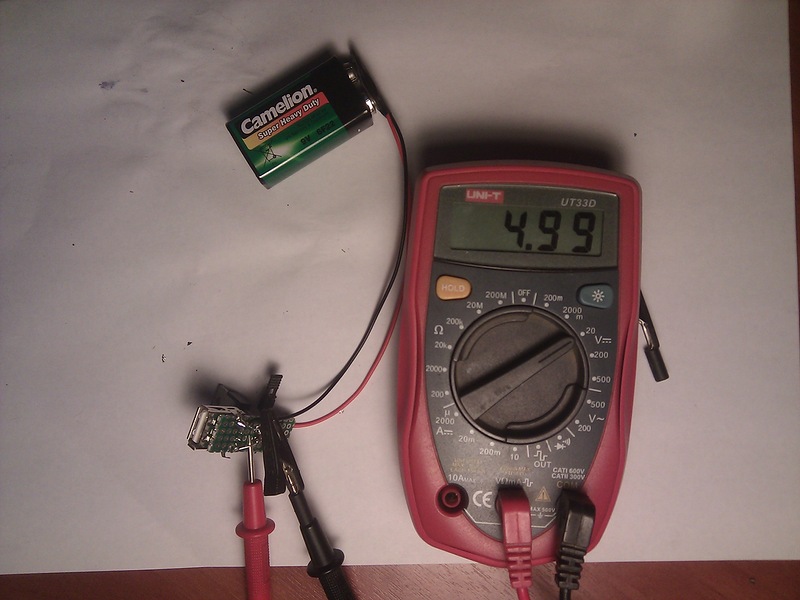
Five volts, as in a pharmacy
It remains only to defuse the phone. To do this, all wireless communications were switched on in active mode, and 10-hour video from YouTube was launched. The device was discharged in about 40 minutes. 4% of the charge was left so that at least somehow it was possible to communicate with the device and monitor its status.
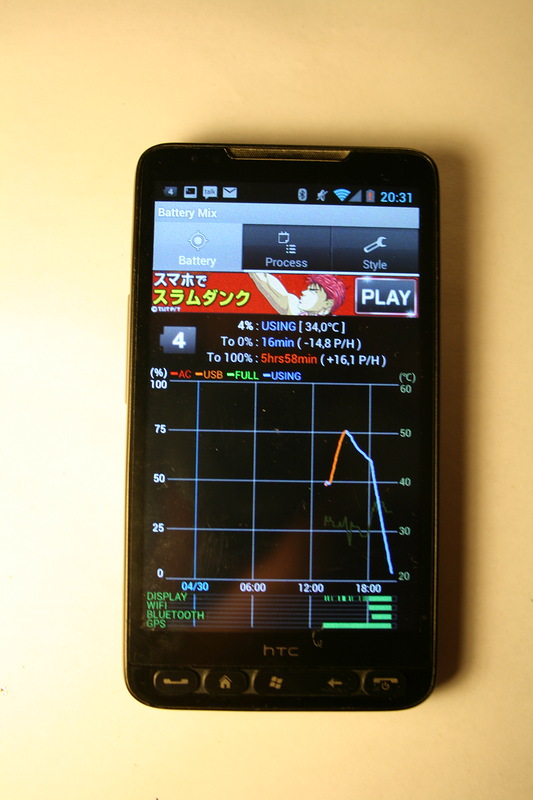
Down to four percent smartphone.
You can see a sharp drop in the graph of the battery of the phone. So, now we have everything ready to begin the experiments.
We start experiments
We connect the phone to our charging. Photo on the entry page of the article. The phone happily tells us that he saw the voltage and started the process of charging.
However, it is interesting not only to see this label, which apparently misled comrade ne_kotin , but to measure the current. We measure the consumed current immediately and after half an hour from the start of charging:
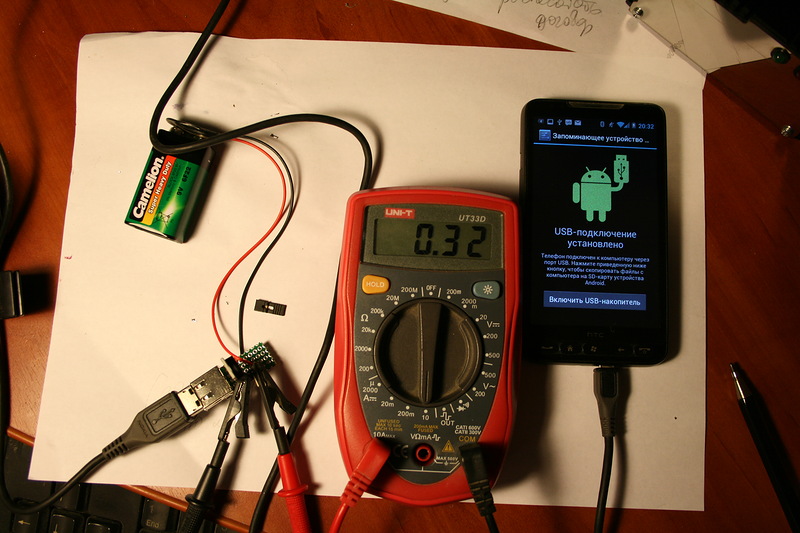
Start charge. Charge current is 300 mA
At the beginning of charging it is quite a good charging current of 300 mA. But here, the claimed 1.5-2 A were not even lying around! Significantly interesting results after half an hour:

After half an hour: the charging current dropped to 100 mA!
The irony is that despite the fact that I transferred the phone to airplane mode, turned off everything, did not touch the display and tried to minimize consumption, strangling all applications, it stubbornly continued to discharge.
An hour later, 1% of the phone charge remained. It was decided to measure the charge voltage and the voltage on the battery. Very interesting results.
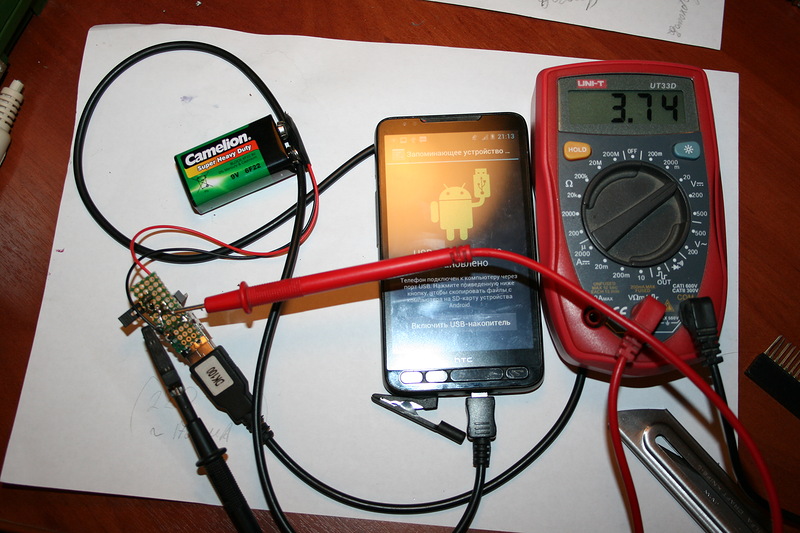
The voltage going to the phone 3.7 V is clearly not enough to charge
I wonder how much is on the battery?

The voltage on the battery is only 5 V !!!!
After that, it was decided to stop the experiment due to its meaninglessness and put the smartphone on a normal charge.
The results of our conditional charge
You probably already guessed that I could not charge the phone in this way. Much more interesting to us will tell about this schedule.

Schedule of discharge, “charging” from the battery, and from the charger
The orange line - this is charging from the crown. As you can see, at the very beginning there were even some attempts to be charged. But then this scheme only slowed down the inevitable death of the phone from the discharge.
Results: it is not possible to use this scheme for charging the phone from the crown!
Why did this happen?
We do the same debriefing, why it happened. First, let's compare the parameters of our crown battery and phone battery. A little google led me to the site of the manufacturer of this battery, from where I took its parameters:

Battery capacity 450 mAh, voltage 9 V.
Let's look at the parameters of the battery of our phone:

Voltage 3.7, capacity 1230 mAh and the most important parameter - battery energy 4.55 Wh
Pay attention to this parameter - as the energy of the battery. The probable energy (if the manufacturer does not lie to us) of our battery will be equal to:
W * h = U * I * h = 9 * 0.45 = 4.05 Wh * h.
Those. in simple terms, even if we could manage to “drink” battery energy without losses, we would never be able to charge her phone! But note that it is impossible to take all the energy from the battery. At least some, but will remain.
Now it is worth considering the efficiency of our power converter and battery charging circuit power. Take the efficiency of the last chain of 80%, with the hope that manufacturers have made it as high as possible. The efficiency of our converter is calculated simply: the ratio of output power to input power.
N = (Uout * Iout) / (Uin * Iin)
Since the input and output currents are almost equal in us (the consumption of the microcircuit is negligible), the ratio is quite simple:
N = 5/9 = 0.56
The final efficiency will be N = 80 * 0.56 = 44.8 , i.e. almost like a good locomotive. As a result, at best, the battery can reach less than half the battery capacity.
But there is more to it. As we remember above, we measured the current that consumed the smartphone from the battery. And in the best of times, it was 300 mA. For the purity of the experiment, measure the charge current when powered by USB and charger. Slightly modifying the scarf to the crown did not participate in the diet, such measurements were made.
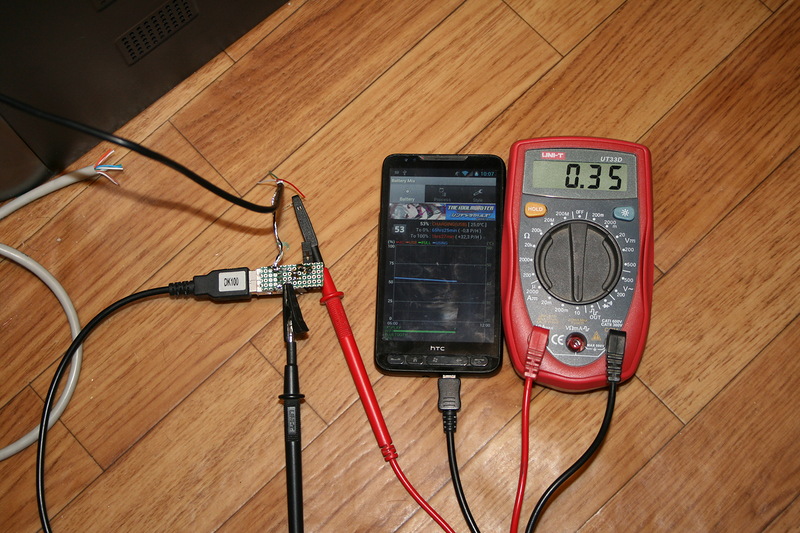
USB port current
It should be immediately noted that the current consumption is stable. And according to the standard, the USB port can give up to a half ampere!
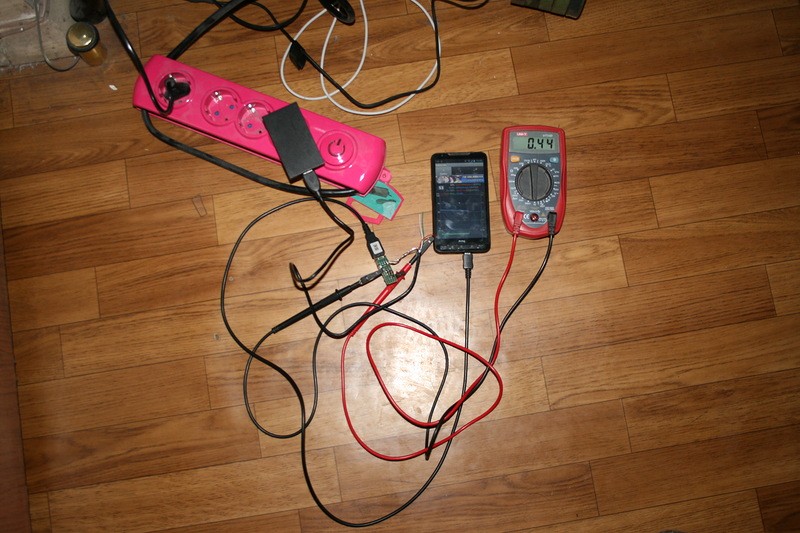
Current consumption from the charger
The last photo is very talking - the phone consumes up to half ampere while charging! And our battery quickly ran out of steam and gave us 100 mA, which was clearly not enough to charge.
What are the solutions to the problem?
Who is to blame, we found out, and what to do? After all, I want to charge on the road!
Well, to start using more capacious batteries. The same scheme with a Krenka would be quite working for itself when charging from a car power supply. In the institute years, the author of these lines made himself a “portable” CD player from a cdrom, a battery from a cash register and an onboard Krenk. It was possible for two hours to listen to music.
Another and more racially correct option is to use a switching power supply. This is a cheaper and correct option. Even the cheapest Chinese cigarette lighter charger in its composition have a switching power supply. For example, here:
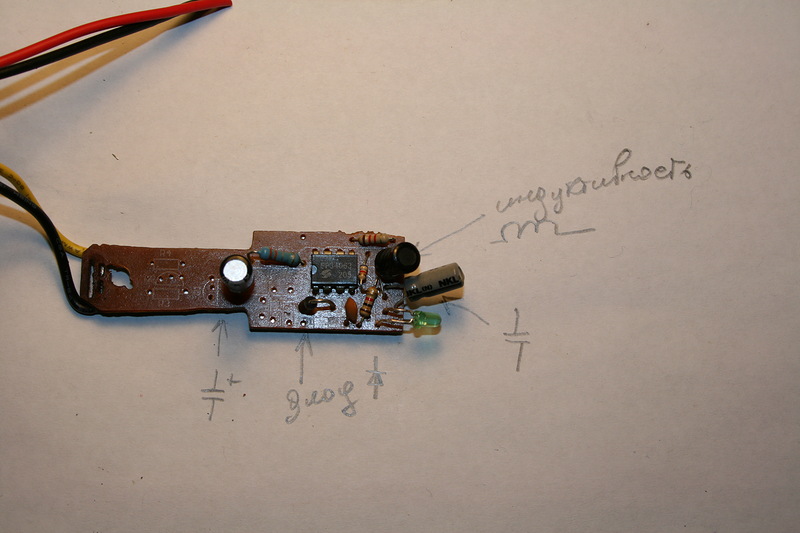
Car Charger from Siemens phones
After a short googling, there is documentation on the microcircuit, and practically the scheme of this charging is given there.

Charging circuit
The topic of pulse converters is huge and inexhaustible. Therefore, we will not dwell on it in detail. Let me just say that there are cheap Chinese converters that can be bought at well-known auctions and solve the problem of charging from batteries.
Readers of this post themselves can link links in the comments.
findings
It is sad when articles of incompetent people appear on Habré and most of them are accepted as useful and interesting. Although, thank God there are few such cases. The irony is that when here a friend told how he “suddenly” discovered the overflow of variables in C, and how he solved it, then the post was wildly mined (to minus 100). And this post was recognized as quite fit, although it describes a much greater and impractical nonsense.
In general, the author ne_kotin misled people by suggesting the use of long-outdated KRENNS, and even more so by offering to use them to charge the phone.
but
Of course, the KREN *** microcircuit (there are many of them), and imported analogs 78 **, as well as all the other linear stabilizers are the perfect solution for low-current circuits. And I rather actively use the analogs of these microcircuits in my sublimations (of course, with significantly better characteristics). Each student is obliged to try to apply them in their handicrafts, but it is absolutely not necessary to write about school handicrafts in Habr, especially adults.
ZY I would be extremely grateful for the criticism of the post, as well as error messages with a personal message.
Source: https://habr.com/ru/post/178555/
All Articles